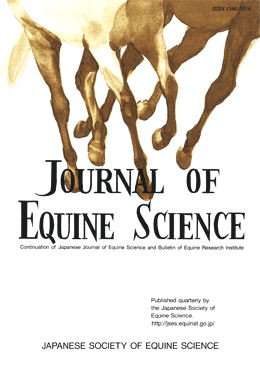
- Issue 4 Pages 55-
- Issue 3 Pages 31-
- Issue 2 Pages 19-
- Issue 1 Pages 1-
- |<
- <
- 1
- >
- >|
-
Carolina Paula BIANCHI, Santiago BRUNO, Ignacio VIDELA DORNA, Edgar ...Article type: Full Paper
2022 Volume 33 Issue 1 Pages 1-6
Published: 2022
Released on J-STAGE: April 19, 2022
JOURNAL OPEN ACCESSIn study I, plasma progesterone concentrations were evaluated in anoestrous mares that received an intravaginal progesterone release device (IPRD) for 10 days. Mares were divided into 3 groups based on the dosage of progesterone (0 g, n=3; 1.38 g, n=5; and 1.9 g, n=5). No statistical differences were found in plasma progesterone concentrations between the two doses tested. In study II, the effects of a protocol based on a short program of artificial light combined with an IPRD containing 1.38 g of progesterone on oestrous behaviour and onset of ovulation were evaluated. IPRDs were inserted into 31 late transitional mares (10 days of treatment). The mares were divided into a control group (n=9, IPRD with 0 g of progesterone) and two treatment groups (T1, n=10, IPRD with 0 g of progesterone and artificial light; T2, n=12, IPRD with 1.38 g of progesterone and artificial light). The percentages of mares in heat within the first 14 days after treatment were 100%, 70%, and 100% in the control, T1, and T2 groups, respectively (P=0.097), and their ovulation rates were 44%, 60%, and 100%, respectively (P≤0.01). In conclusion, a protocol based on artificial light and an IPRD containing 1.38 g of progesterone for 10 days could be considered to advance the first ovulation of the year in late transitional mares, as it ensures a higher rate of ovulation within the first 14 days after treatment.
View full abstractDownload PDF (514K)
-
Koji HARADA, Saori KANEMITSU, Kohei AKIOKA, Kazunari FUJITA, Yasunobu ...Article type: Note
2022 Volume 33 Issue 1 Pages 7-12
Published: 2022
Released on J-STAGE: April 19, 2022
JOURNAL OPEN ACCESSFifty-four slaughtered horses were classified into groups having adipose tissue in the crest of the neck with or without hemorrhage (AH and NH groups, respectively). Blood biochemical tests (Alb, TP, T-bil, GOT, GPT, LDH, T-cho, and BUN) and an epidemiological survey (age, gender, weight, origin, breed, BCS, CNS, and hoof disease) were performed. T-bil tended to be high, while the other parameters were normal. Weight, BCS, and CNS were higher in the AH group (P<0.05). GOT was lower in the AH group (P<0.05). It was suspected that the horses in the AH group had lipomatosis. It was assumed that the adipose tissue of the horses in the AH group contained damaged capillaries, and inflammation was confirmed based on evidence of macrophages and lymphocytes.
View full abstractDownload PDF (967K) -
Hajime OHMURA, Atsushi HIRAGAArticle type: Note
2022 Volume 33 Issue 1 Pages 13-17
Published: 2022
Released on J-STAGE: April 19, 2022
JOURNAL OPEN ACCESSThis study aimed to investigate the effect of transportation and restraint in a van on heart rate (HR) and HR variability in Thoroughbreds. Eight healthy Thoroughbreds were exposed to four conditions, each for a duration of 30 min: stall rest (REST), restraint inside a van (VAN), restraint inside a van with the engine running (V + E), and road transportation (TRANS). Electrocardiograms were recorded to determine HR, low-frequency (LF) power, high-frequency (HF) power, and LF/HF ratio. During TRANS, HR was significantly greater than during REST and V + E. There was a significant increase during VAN compared with REST. These results demonstrated that restraint inside the transport vehicle was one of the major stressors that may cause physiological changes during transportation.
View full abstractDownload PDF (729K)
- |<
- <
- 1
- >
- >|